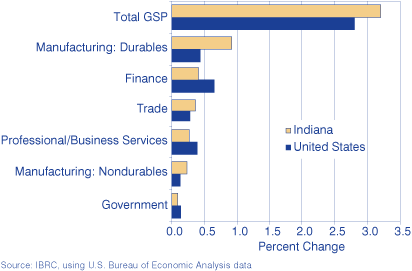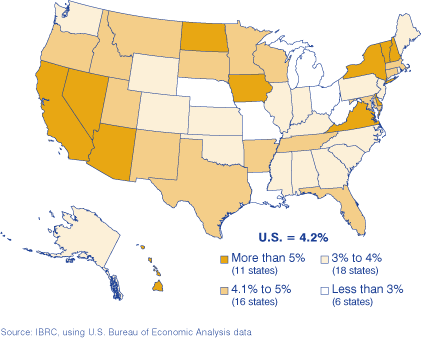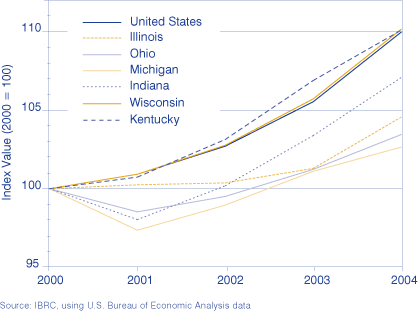The Indiana Dichotomy: Economy Grows but Lags Nation
The economic expansion has picked up steam as every state in the nation experienced economic growth in 2004, according to new data released by the U.S. Bureau of Economic Analysis (BEA). Indiana’s growth, however, lagged behind the national average.
These conclusions are based on preliminary estimates of gross state product (GSP), the most comprehensive measure of overall economic activity in each state. Using a prototype methodology designed to accelerate GSP estimates, the BEA data have been released a full year sooner than past GSP figures. This release estimates total state output in 2004, but estimates of output by industry for 2004 are still several months away.
Indiana’s GSP in 2004 was $208.4 billion, ranking the Hoosier state 15th in the nation for total output, a position Indiana has held steadily for several years (see Table 1). To overtake Washington and move into 14th place, Indiana’s economy would have to grow by more than $30 billion per year; and the gap to 13th place, Massachusetts, is even greater at $90 billion. Looking the other direction, Minnesota and Maryland are hot on Indiana’s heels with economies less than one percent smaller than Indiana’s.
Table 1: Total Real GSP (Millions of 2000 Dollars) in the Midwest, 2000 through 2004
Ranks: Use with Caution
Indiana’s output growth of 3.6 percent over 2003 was slower than the U.S. average of 4.2 percent, ranking Indiana only 35th among the states for year-over-year economic growth (see Figure 1). A national organization focused on technology-based economic growth recently raised concerns among some Hoosier observers when it noted that Indiana ranked 43rd among the states in GSP growth. However, this ranking was based on the four-year GSP change from 2000 to 2004, which involves a very different base year for comparison than the figures cited above. In 2000, Indiana began a major decline in employment while much of the rest of the nation was still enjoying a growing economy (Figure 2). It is important to remember that rankings do not reveal the size of differences between states in the underlying variable. For example, an increase of just one percentage point in Indiana’s growth rate from 2003 to 2004 would have raised the state’s growth rank from 35th to 19th.
Figure 1: Percent Change in GSP, 2003 to 2004
Figure 2: Relative Change in Total GSP, 2000 to 2004
Growth Contributors
Looking further into the GSP data, Figure 3 shows which industries contributed to changes in GSP. For 2002 to 2003 (2004 industry data are not yet available), a period over which Indiana’s GSP growth was notably stronger than the nation (ranked 19th in one-year growth). Indiana’s manufacturing output (both durable and nondurable goods) as a percent of GSP led the national average by large margins, contributing more than a third of the total state growth in GSP that year. Even as we lost many manufacturing jobs during this period, our manufacturers became significantly more productive; their outputs increased as did their employee compensation.
Figure 3: Contribution to Change in State GSP, 2002 to 2003

Another significant contributor to Indiana’s growth was trade, where we again outpaced the national average. During the 2002–2003 period, Indiana’s GSP was also boosted substantially by financial activities, but this sector trailed the national average (for the nation as a whole, finance was the biggest contributor to change in total GSP). Finally, another sector that helped Indiana grow, but not as much as the national average, was professional and business services.
Further discussion of the new GSP figures and detailed data for individual states are available online at www.bea.gov/regional/gsp/. More detailed rankings of Indiana compared to the nation are available on STATS Indiana’s States in Profile at www.stats.indiana.edu.
By Jerry Conover, Director
Indiana Business Research Center, Kelley School of Business, Indiana University



